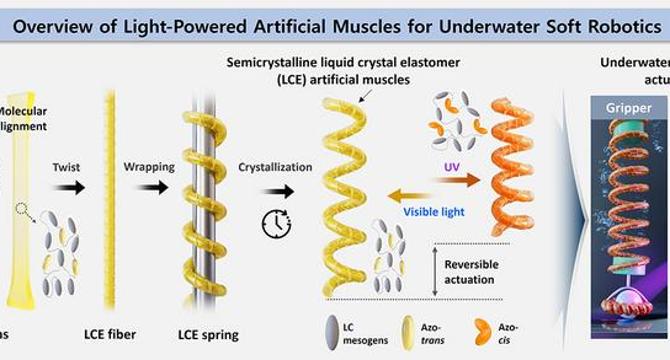Bioengineer
1d
225

Image Credit: Bioengineer
Revolutionary Light-Driven Artificial Muscles Enable High-Stroke Actuation in Underwater Robots
- A Korean research team has developed light-powered artificial muscles for underwater robots, enabling high-stroke actuation in challenging aquatic environments.
- The artificial muscles, made of azobenzene-functionalized semicrystalline liquid crystal elastomers (AC-LCEs), respond to light for movement, overcoming limitations of traditional energy-dependent actuators.
- Underwater actuation has been a challenge due to cooling effects, but the AC-LCEs contract under UV light and expand under visible light, offering dynamic motion capabilities.
- The artificial muscles can maintain a deformed state once the light source is removed, allowing for a 'latch-like' locking mechanism that enhances control over robotic motion.
- These AC-LCEs display significantly higher actuation strains and work capacity compared to previous actuators, presenting a promising advancement in soft robotics for underwater applications.
- The research team's innovative approach allows reversible direction of actuation, offering versatility for underwater robots to perform tasks such as gripping, navigating, and moving through confined spaces.
- The developments eliminate the need for traditional components like batteries, wires, or pumps, enhancing the efficiency and reliability of untethered underwater robotic systems.
- The artificial muscles demonstrated robust and efficient performance over 100 light cycles, indicating their durability and potential for real-world applications in dynamic underwater environments.
- The research, set to be published in the journal Small, signifies a significant step in light-powered soft robotics, with implications for underwater exploration, environmental conservation, and beyond.
- This breakthrough showcases the innovative potential of light-powered actuators, paving the way for advancements in diverse sectors such as technology, biology, and environmental sciences.
- As the team prepares for commercialization by 2030, their work underscores the transformative impact of this research on underwater robotics, offering new opportunities for engineering and scientific exploration.
Read Full Article
13 Likes
For uninterrupted reading, download the app